
James Donald "Wxb" Wetherbee, is a retired United States Navy officer and aviator, test pilot, aerospace engineer, and NASA astronaut. He is a veteran of six Space Shuttle missions and is the only American to have commanded five spaceflight missions.

STS-49 was NASA's maiden flight of the Space Shuttle Endeavour, which launched on May 7, 1992. The primary goal of its nine-day mission was to retrieve an Intelsat VI satellite, Intelsat 603, which failed to leave Low Earth orbit two years before, attach it to a new upper stage, and relaunch it to its intended geosynchronous orbit. After several attempts, the capture was completed with the only three-person extravehicular activity (EVA) in space flight history. It would also stand until STS-102 in 2001 as the longest EVA ever undertaken.

STS-61 was NASA's first Hubble Space Telescope servicing mission, and the fifth flight of the Space Shuttle Endeavour. The mission launched on December 2, 1993, from Kennedy Space Center (KSC) in Florida. The mission restored the spaceborne observatory's vision with the installation of a new main camera and a corrective optics package (COSTAR). This correction occurred more than three and a half years after the Hubble was launched aboard STS-31 in April 1990. The flight also brought instrument upgrades and new solar arrays to the telescope. With its very heavy workload, the STS-61 mission was one of the most complex in the Shuttle's history.

STS-69 was a Space Shuttle Endeavour mission, and the second flight of the Wake Shield Facility (WSF). The mission launched from Kennedy Space Center, Florida on 7 September 1995. It was the 100th successful crewed NASA spaceflight, not including X-15 flights.
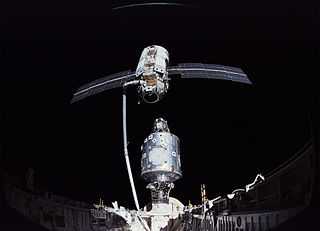
STS-88 was the first Space Shuttle mission to the International Space Station (ISS). It was flown by Space Shuttle Endeavour, and took the first American module, the Unity node, to the station.
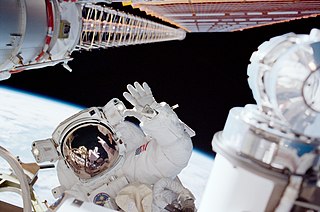
STS-97 was a Space Shuttle mission to the International Space Station (ISS) flown by Space Shuttle Endeavour. The crew installed the first set of solar arrays to the ISS, prepared a docking port for arrival of the Destiny Laboratory Module, and delivered supplies for the station's crew. It was the last human spaceflight of the 20th century.

Linda Maxine Godwin is an American scientist and retired NASA astronaut. Godwin joined NASA in 1980 and became an astronaut in July 1986. She retired in 2010. During her career, Godwin completed four space flights and logged over 38 days in space. Godwin also served as the assistant to the director for exploration, Flight Crew Operations Directorate at the Johnson Space Center. Since retiring from NASA, she accepted the position of professor in the Department of Physics and Astronomy at the University of Missouri.

Gregory Jordan "Greg" Harbaugh is an aeronautical/astronautical engineer and former NASA astronaut. He flew on four space shuttle missions as a mission specialist with responsibilities that included Remote Manipulator System (RMS) operation and Extravehicular Activity (EVAs). He performed three spacewalks during the shuttle missions including in support of repair/refurbishment of the Hubble Space Telescope.

Richard Alan Mastracchio is an American engineer and former NASA astronaut. He has flown on three NASA Space Shuttle missions as a mission specialist in addition to serving as a flight engineer on the Soyuz TMA-11M long-duration mission aboard the International Space Station. He is currently the senior director of operations for commercial resupply services at Orbital ATK.

Mary Ellen Weber is an American executive, scientist, aviator, and a former NASA astronaut.

STS-116 was a Space Shuttle mission to the International Space Station (ISS) flown by Space Shuttle Discovery. Discovery lifted off on December 9, 2006, at 20:47:35 EST. A previous launch attempt on December 7 had been canceled due to cloud cover. It was the first night launch of a Space Shuttle since STS-113 in November 2002.
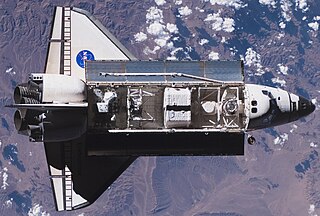
STS-118 was a Space Shuttle mission to the International Space Station (ISS) flown by the orbiter Endeavour. STS-118 lifted off on August 8, 2007, from launch pad 39A at Kennedy Space Center (KSC), Florida and landed at the Shuttle Landing Facility at KSC on August 21, 2007.

Michael Edward Fossum is a former American astronaut, engineer, and the Chief Operating Officer of Texas A&M University at Galveston. He flew into space on board the NASA Space Shuttle missions STS-121 and STS-124 and served as a mission specialist of Expedition 28 and commander of Expedition 29 aboard the International Space Station.

Stephanie Diana Wilson is an American engineer and a NASA astronaut. She flew to space onboard three Space Shuttle missions, and is the second African American woman to go into space, after Mae Jemison. As of 2022, her 42 days in space are the second most of any female African American astronaut, having been surpassed by Jessica Watkins in 2022, however in 2024 she was assigned to the Crew-9 mission during which she should retake the lead.
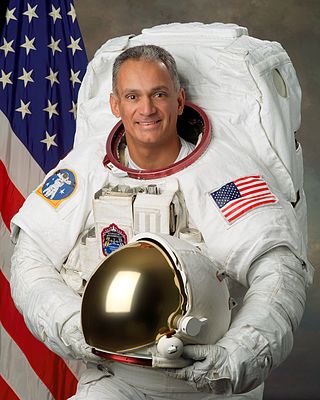
John Daniel "Danny" Olivas is an American engineer and a former NASA astronaut. Olivas has flown on two space shuttle missions, STS-117 and STS-128. He performed EVAs on both missions, totaling 34hrs 28min.

STS-123 was a Space Shuttle mission to the International Space Station (ISS) which was flown by Space Shuttle Endeavour. STS-123 was the 1J/A ISS assembly mission. The original launch target date was February 14, 2008, but after the delay of STS-122, the shuttle was launched on March 11, 2008. It was the twenty-fifth shuttle mission to visit the ISS, and delivered the first module of the Japanese laboratory, Japanese Experiment Module (Kibō), and the Canadian Special Purpose Dexterous Manipulator, (SPDM) Dextre robotics system to the station. The mission duration was 15 days and 18 hours, and it was the first mission to fully utilize the Station-to-Shuttle Power Transfer System (SSPTS), allowing space station power to augment the shuttle power systems. The mission set a record for a shuttle's longest stay at the ISS.

Stephen Gerard"Steve"Bowen is a United States Navy submariner and a NASA astronaut; he was the second submariner to travel into space. Bowen has been on four spaceflights, the first three of which were Space Shuttle missions to the International Space Station. His first mission, STS-126, took place in November 2008, and his second was STS-132 in May 2010. His third was STS-133 in February 2011, and his fourth was SpaceX Crew-6 in March 2023.
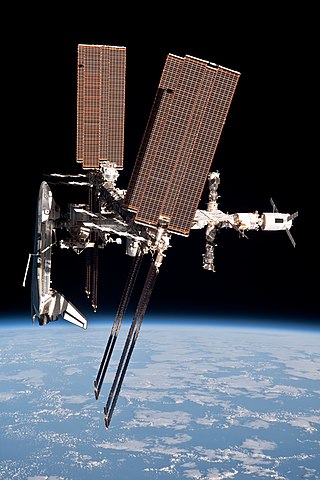
STS-134 was the penultimate mission of NASA's Space Shuttle program and the 25th and last spaceflight of Space ShuttleEndeavour. This flight delivered the Alpha Magnetic Spectrometer and an ExPRESS Logistics Carrier to the International Space Station. Mark Kelly served as the mission commander. STS-134 was expected to be the final Space Shuttle mission if STS-135 did not receive funding from Congress. However, in February 2011, NASA stated that STS-135 would fly "regardless" of the funding situation. STS-135, flown by Atlantis, took advantage of the processing for STS-335, the Launch on Need mission that would have been necessary if the STS-134 crew became stranded in orbit.

NASA Astronaut Group 16 was a group of 44 astronauts announced by NASA on May 1, 1996. The class was nicknamed "The Sardines" for being such a large class, humorously implying that their training sessions would be as tightly packed as sardines in a can. These 44 candidates compose the largest astronaut class to date. NASA selected so many candidates in preparation for the anticipated need for ISS crew members, along with regular shuttle needs. Nine of the 44 astronauts selected were from other countries including 5 from Europe and 2 from Canada and Japan.
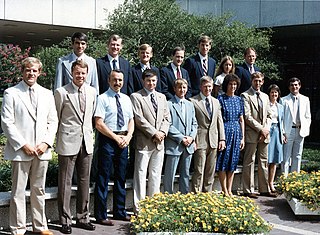
NASA Astronaut Group 10 was a group of 17 astronauts that were announced on May 23, 1984 and consisted of seven pilots and ten mission specialists. Although selected in 1984, no member of the group would fly until 1988 due to the Challenger disaster and the resulting grounding of the Space Shuttle fleet.





















